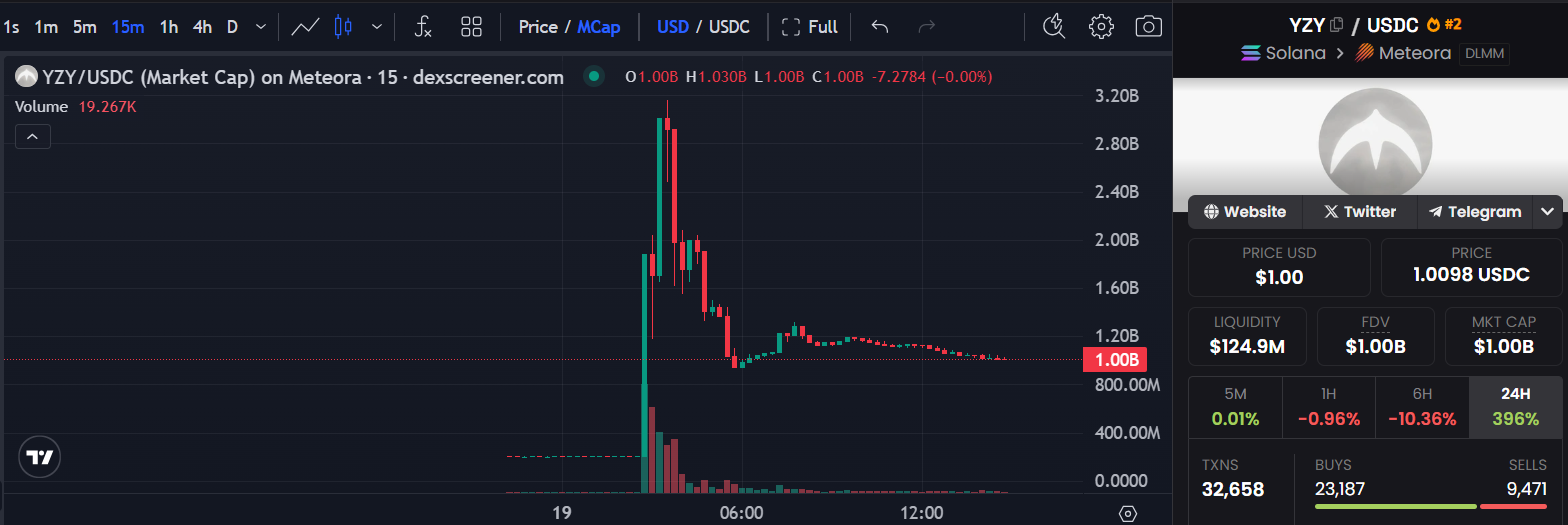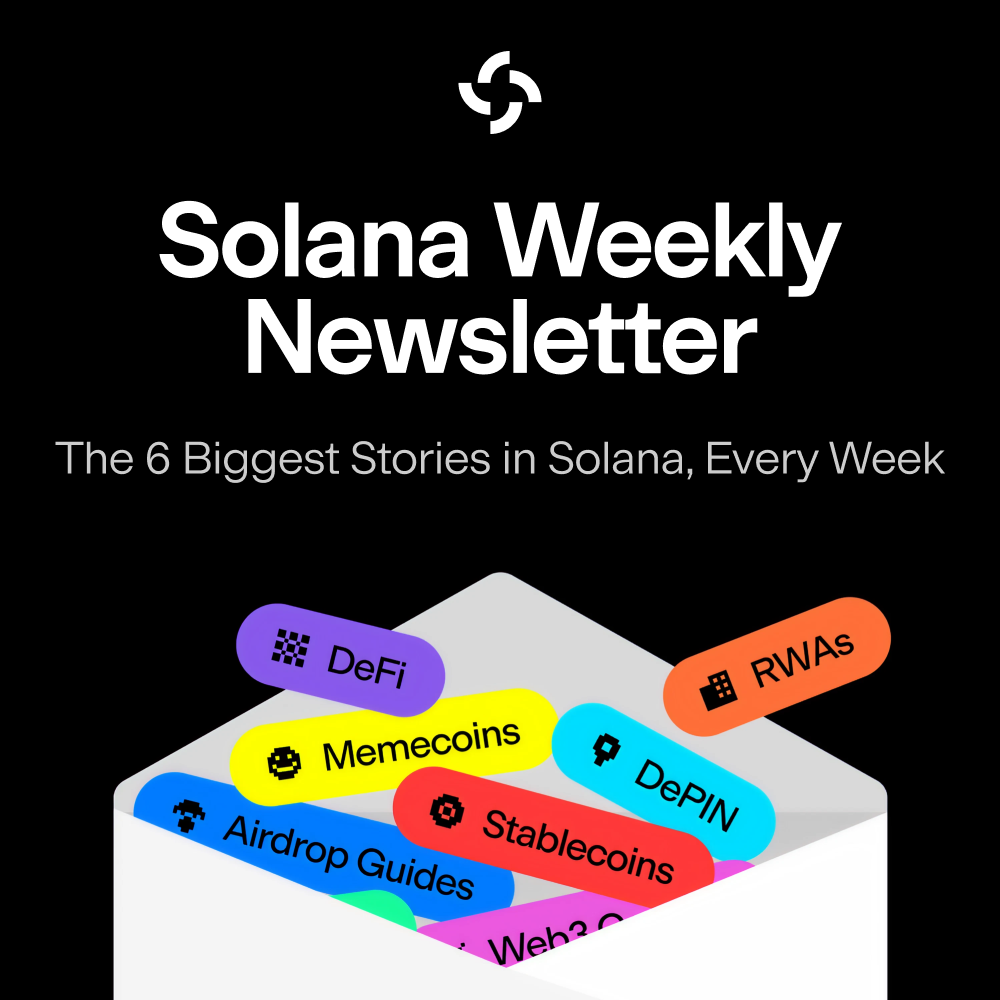
Rapper Kanye West, now known as Ye, has officially entered the cryptocurrency arena with the launch of the long-awaited $YZY token on Solana, following months of rumours about him launching a coin. West shared the contract address via an X post on Thursday, August 21, accompanied by a self-filmed video to confirm the launch shortly after.
Within 2 hours of going live, the token hit a staggering $3 billion market capitalization. The rapid ascent highlighted both the power of celebrity-backed tokens and the speculative fervor in Solana’s memecoin ecosystem. Onchain trading volume reached $512 million within the first three hours. Dex Screener data shows that $YZY currently has a market cap of $1 billion.
The launch also coincided with a technical milestone for Solana. The network recorded 2,300 true transactions per second, marking a new all-time high and showcasing improvements since the widely publicized congestion during the $TRUMP token launch earlier this year.
Tokenomics and Structure
According to the official $YZY website, the tokenomics allocate 20 percent of the supply to the public, 10 percent to liquidity, and the remaining 70 percent under the control of Yeezy Investments LLC. Data from Bubblemaps confirmed that the onchain distribution closely matches the breakdown presented on the site.
In an unusual move, the project deployed 25 separate contract addresses, with one selected at random to serve as the official token. The website states: “25 contract addresses for the $YZY have been deployed, with one selected at random for the official $YZY. This dissuades snipers by making it a 1/25 chance for selection of the right CA, putting power back into the hands of real traders.” The team clarified that this move is part of their anti-sniping system.
Onchain analysis further revealed that the $YZY team added 30 million $YZY, worth $33.81 million, to a liquidity pool. The pool was structured with a price range of $3.17 to $4.49. This means West will begin earning fees once the price surpasses $3.17, but the entirety of the tokens in the pool will be sold if the price rises beyond $4.49. This setup likely contributed to downward price pressure, and it may have been one of the reasons the token’s market value began to decline from those levels.
Allegations of Insider Trading
Despite the structured rollout, the launch raised suspicions quickly. Observers pointed out similarities between $YZY and other controversial celebrity coins such as $LIBRA, which was promoted earlier this year by Argentina’s President Javier Milei. Like $LIBRA, $YZY’s liquidity pool was initially one-sided, consisting only of project tokens without an equivalent base pair.
Coinbase Director Conor Grogan highlighted that 94 percent of the $YZY supply was in the hands of insiders, with 87 percent concentrated in a single multisig wallet before distribution.
Onchain analytics firm Lookonchain noted that the liquidity pool design allowed developers to alter liquidity at will, raising fears that tokens could be sold off without warning. Although there is no confirmation that the $LIBRA team is involved in this launch, speculation persists. Fueling concerns, a Manhattan federal judge unfroze $57.6 million in USDC linked to $LIBRA yesterday, August 20, granting Hayden Davis access to the funds. Davis has been accused of orchestrating controversial launches earlier this year, although no formal link has been established with $YZY.
Legal and User Protection Concerns
The $YZY website presents its offering as the foundation of “YZY MONEY,” described as “a concept to put you in control, free from centralized authority.” Yet the fine print tells a different story. The terms of service explicitly exclude users in restricted jurisdictions and warn of the “potential for complete loss.”
More controversially, the website contains a class action waiver. This clause prevents token holders from pursuing claims as part of a collective lawsuit, forcing disputes into individual arbitration. One critic described the waiver as granting the project “permission to rug” its users. The agreement also stipulates that challengers may be required to pay legal fees and court costs if they attempt to bypass the provision.
The Broader Context of Celebrity Tokens
Kanye West is not the first high-profile figure to launch a cryptocurrency. In February, Argentina’s President Javier Milei publicly endorsed the $LIBRA token, which soared to a $4 billion market capitalization before collapsing within hours amid revelations of insider trading and concentrated ownership. Milei later deleted his endorsement post and disavowed the project, but the fallout led to allegations of fraud, legal action, and the freezing of assets tied to the token. Prior to $LIBRA, U.S. President Donald Trump had also unveiled his $TRUMP token before his inauguration in January, fueling a wave of political memecoins.
These launches highlight the risks of celebrity-driven projects. They can generate staggering levels of hype and liquidity in a short period, but the sustainability of such ventures remains in question. The track record shows that celebrity-backed tokens often stumble amid allegations of insider enrichment and regulatory gray areas.
The $YZY launch represents both a technical success for Solana and a stark reminder of the fragility of hype-driven token economies. While the network demonstrated resilience under record demand, the concerns surrounding insider control and restrictive legal terms continue to overshadow the token’s early momentum.
Investors remain divided. Supporters point to Solana’s performance and Kanye West’s global influence as reasons to believe the project could evolve into something substantial. Critics, however, see the same warning signs that defined earlier scandals in the memecoin space. Despite these concerns, many celebrities and projects from other ecosystems, such as Pudgy Penguins, now choose Solana as their platform of choice, which demonstrates its growing mindshare and ability to handle high-profile launches without issues. Smooth launches at scale are increasingly only possible on Solana, reinforcing its reputation as the most active chain in the crypto ecosystem.
Read More on SolanaFloor
“Finance At the Speed of Light”: Bullish Raises $1.15 Billion in Stablecoins Through IPO
A President, an Unknown Venture Fund, KOL Insider Trading, and 9 Figures in Extracted Value—What Happened With $LIBRA?
Did Orca Just Change Solana Launchpads Forever?



